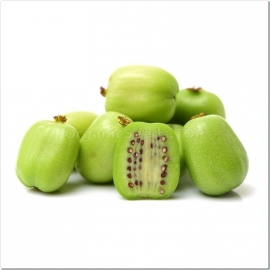


«Hardy Kiwi» - Organic Actinidia Arguta Seeds
1.14 €
From Japan and China, where it can be found climbing to the tops of the tallest trees, comes this rather fine, strong-growing, twining climber with bristly-toothed leaves and bearing in summer clusters of three or so fragrant.
-
Organic Actinidia Arguta «Hardy Kiwi»
From Japan and China, where it can be found climbing to the tops of the tallest trees, comes this rather fine, strong-growing, twining climber with bristly-toothed leaves and bearing in summer clusters of three or so fragrant, white flowers with contrasting purple anthers.
The fleshy, emerald-green fruits that follow are considered to be sweeter than the now common Kiwi Fruit and can be eaten raw or made into jam or wine. Not only that, but the stems are rich in sap which is drinkable. 25ft (8m).
How to Grow
- Use a planter that is at least twice as large as the diameter of the mini kiwi's root ball and slightly deeper, with drainage holes and a catch basin. To plant the mini-kiwi in the ground, choose a well-drained spot with either partial shade or full sun, as kiwis will not thrive in a shady spot. Dig a hole with a spade that is twice as large as the root ball and slightly deeper.
- Plant the mini kiwi vine against a fence or add a trellis at the time of planting, as the vines need support. Avoid adding it to the vine later or you could damage the root ball.
- Place the mini kiwi's root ball in the hole and center it. Hold it straight while backfilling the hole in with a mix of quality topsoil and organic material, such as compost. Once the hole is filled, push down on the soil firmly but gently.
- Water the planted vine thoroughly, but do not leave the mini kiwi sitting in puddled water. Make sure the ground drains well. Keep the mini kiwi watered during the growing season to keep it from stress.
- Apply a fertilizer commonly used on citrus trees around the vine in spring after the last chance of frost, making sure to water the ground well to help it reach the roots of the mini kiwi vine. Apply several additional applications during the early summer, spaced out every two to three weeks, to establish roots and provide nutrients in basic soil composition.
- Prune off older canes each winter to allow newer shoots more access to the mini kiwi vine's water and nutrients. The plant should have a strong central vine from which all other vines protrude; leave the central vine alone.
